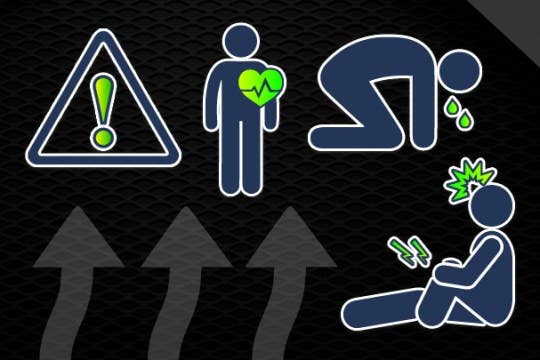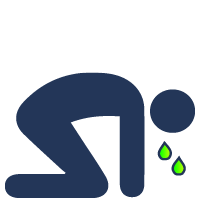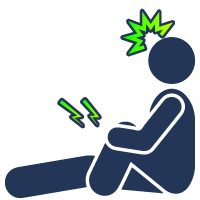
5 Ways Heat Stress Impacts Workplace Safety
By John Heniff, Safety Writer, Magid
You know you’ve been in the sun too long when your skin gets sunburned or you’re drenched in sweat. But did you know there are other lesser known (and more dangerous!) ways heat and humidity can affect you? With worldwide temperatures rising, more jobsites will become even hotter in the coming years, putting more workers at increased risk and making it harder to keep them safe. Learn about five dangerous effects of working in the heat to educate your workers and keep everyone on the lookout for safety. Some of them may surprise you!


HERE ARE 5 WAYS HEAT STRESS
IMPACTS WORKPLACE SAFETY


1. HEAT STRESS MAKES IT HARD TO THINK
When you’re out in the heat, your body has to use more energy and work harder to maintain a normal body temperature. According to a study in Scientific American, when this happens, our brains tend to make more straightforward and simple choices (even if they lead to worse results). Additionally, the heat also disrupts our thought process when making complex decisions.
Similar results were found when comparing students taking tests. Students who lived in a building without air-conditioning were observed to have a 13% longer reaction time compared to students taking the same tests who lived in a building with air-conditioning. The cooler students also gave more correct responses than the warmer ones.
Different studies report that warmer weather can decrease standardized test scores, increase the risk of judgment errors, and reduce performance on exams by around 11 percent when compared to exams taken on days with mild temperatures. And while these studies dealt mostly with students, the findings are relevant to workers on a hot jobsite trying to make decisions and remember safety protocols.


2. HEAT STRESS SENDS MORE WORKERS TAKING MEDICATION AND WITH PRE-EXISTING CONDITIONS TO THE EMERGENCY ROOM
Workers living with medical issues as common as high blood pressure or allergies may be at greater risk for problems in the heat. A recent study also found that people with mood and anxiety disorders or substance abuse had increased visits to the emergency room when they were exposed to short-term extreme heat. The cause of this can vary from certain conditions or medications weakening the body’s ability to regulate hydration and body temperature, to workers being so exhausted that their bodies aren’t able to withstand the intense heat.


3. HEAT STRESS + POOR SLEEP = ACCIDENTS
Projections indicate warmer nighttime temperatures will continue to increase, making it even more important to rest and recharge. If the room a worker is sleeping in is humid and uncomfortable, they’re less likely to get a full night’s rest. Without that deep sleep, they’ll feel tired, work at a slower pace, take more breaks, make more mistakes, and be at greater risk of suffering an injury. If you know your workers are going home to hot sleeping conditions, consider sending them home with cooling gear to help them sleep and perhaps reduce accidents.


4. HEAT STRESS INCREASES ACCIDENTS & INJURIES
A UCLA study observed that more jobsite injuries and accidents occur on hot days, even if heat didn’t play a direct factor. Workers were between 6-9 percent more likely to injure themselves or suffer an accident if the temperature was above 90⁰ Fahrenheit and 10-15 percent more likely when the temperature was over 100⁰ Fahrenheit.


5. HEAT STRESS CAUSES HIGHER ABSENTEEISM
Garment sewers said they were more likely to remain at home on a hot day after a six-day stretch of temperatures over 95⁰ Fahrenheit, in one survey. Similar answers were recorded from steel product makers on highly mechanized shop floors. If geographical trends continue with more areas getting warmer and more difficult to work in, we can expect absenteeism to increase and spread to other industries.


WHAT ARE THE BEST WAYS TO PROTECT YOUR WORKERS FROM HEAT STRESS?
With many of these factors out of your control, it’s important to mitigate the heat when and wherever you can. Make sure your workers are protected from the minute they step onto the jobsite to the minute they leave (and beyond!) by building a comprehensive heat safety plan. The latest research from the Heat Safety & Performance Coalition (HSPC) (formerly the National Heat Safety Coalition) points to eight separate actions to create an all-encompassing strategy. An effective plan will teach and remind your workers about the dangers of heat illness, emergency protocols, and prevention measures.
It also includes:
- Providing cool water or electrolyte-replacting beverages immediately near the jobsite for easy access before, during, or after work
-
Establishing body cooling stations in shady and cool locations away from the heat so workers can relax and rest
-
Using the process of acclimatization to prepare workers' bodies for the heat stress of their job over a period of at least 5-7 days
-
Handing out physiological monitors like heart rate trackers or smartwatches that can help workers track skin temperature or heart rate
-
Picking up a Wet Bulb Globe Temperature (WBGT) monitor to find the true temperature of all areas of your jobsite.
-
Providing body cooling gear designed to cool workers throughout the day, even while they’re working. This can not only keep workers safer, but it might make them more productive too! Body cooling PPE used in pre-cooling and per-cooling (during exercise) has been found to enhance exercise performance in athletes up to 6 percent. Think how much more productive workers in the heat can be with cooling interventions that they can use throughout the workday!







